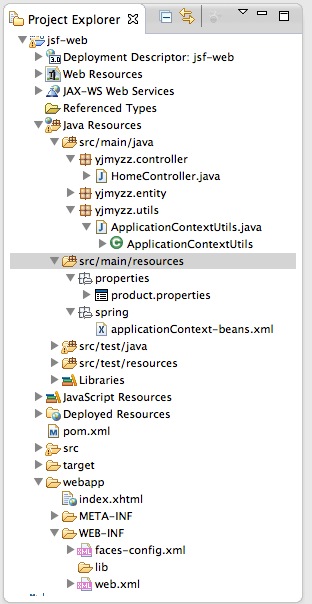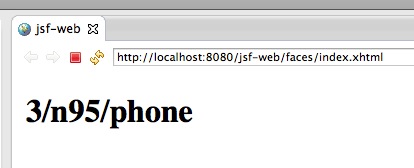spring-自动加载配置文件\使用属性文件注入
在上一篇jsf环境搭建的基础上 , 加入spring框架 , 先看下目录结构

src/main/resources 这个source folder 放置web项目所需的主要配置,打包时,会自动打包到WEB-INF下
首先看下pom.xml,需要引入一些依赖项:
<project xmlns="http://maven.apache.org/POM/4.0.0" xmlns:xsi="http://www.w3.org/2001/XMLSchema-instance"
xsi:schemaLocation="http://maven.apache.org/POM/4.0.0 http://maven.apache.org/xsd/maven-4.0.0.xsd">
<modelVersion>4.0.0</modelVersion>
<groupId>yjmyzz</groupId>
<artifactId>jsf-web</artifactId>
<version>1.0</version>
<packaging>war</packaging> <dependencies>
<!-- 单元测试 -->
<dependency>
<groupId>junit</groupId>
<artifactId>junit</artifactId>
<version>4.7</version>
<scope>test</scope>
</dependency> <!-- jsf -->
<dependency>
<groupId>org.jboss.spec.javax.faces</groupId>
<artifactId>jboss-jsf-api_2.1_spec</artifactId>
<version>2.1.19.1.Final-redhat-1</version>
<scope>compile</scope>
</dependency> <!-- spring -->
<dependency>
<groupId>org.springframework</groupId>
<artifactId>spring-context</artifactId>
<version>4.0.2.RELEASE</version>
</dependency> <dependency>
<groupId>org.springframework</groupId>
<artifactId>spring-web</artifactId>
<version>4.0.2.RELEASE</version>
</dependency> <!-- servlet支持 -->
<dependency>
<groupId>javax.servlet</groupId>
<artifactId>servlet-api</artifactId>
<version>2.5</version>
</dependency> </dependencies> <build>
<plugins>
<plugin>
<artifactId>maven-compiler-plugin</artifactId>
<version>3.1</version>
<configuration>
<source>1.7</source>
<target>1.7</target>
</configuration>
</plugin>
<plugin>
<artifactId>maven-war-plugin</artifactId>
<version>2.3</version>
<configuration>
<warSourceDirectory>webapp</warSourceDirectory>
<failOnMissingWebXml>false</failOnMissingWebXml>
</configuration>
</plugin>
</plugins>
</build>
</project>
pom.xml
1. 自动加载配置文件
在web项目中,可以让spring自动加载配置文件(即上图中的src/main/resouces/spring下的xml文件),WEB-INF/web.xml中参考以下设置:
<?xml version="1.0" encoding="UTF-8"?>
<web-app xmlns:xsi="http://www.w3.org/2001/XMLSchema-instance" xmlns="http://java.sun.com/xml/ns/javaee" xsi:schemaLocation="http://java.sun.com/xml/ns/javaee http://java.sun.com/xml/ns/javaee/web-app_3_0.xsd" id="WebApp_ID" version="3.0">
<display-name>jsf-web</display-name> <welcome-file-list>
<welcome-file>index.html</welcome-file>
</welcome-file-list> <listener>
<listener-class>
org.springframework.web.context.ContextLoaderListener
</listener-class>
</listener> <context-param>
<param-name>contextConfigLocation</param-name>
<param-value>
classpath*:spring/applicationContext-*.xml
</param-value>
</context-param> </web-app>
web.xml
解释一下: classpath*:spring/applicationContext-*.xml 这里表示将加载classpath路径下 spring目录下的所有以applicationContext-开头的xml文件 , 通常为了保持配置文件的清爽 , 我们会把配置分成多份 : 比如 applicationContext-db.xml 用来配置DataSource , applicationContext-cache.xml用来配置缓存...等等.
2.代码中如何取得ApplicationContext实例
package yjmyzz.utils; import javax.faces.context.FacesContext;
import javax.servlet.ServletContext; import org.springframework.context.ApplicationContext;
import org.springframework.web.context.support.WebApplicationContextUtils; public class ApplicationContextUtils { public static ApplicationContext getApplicationContext() {
ServletContext context = (ServletContext) FacesContext
.getCurrentInstance().getExternalContext().getContext();
ApplicationContext appctx = WebApplicationContextUtils
.getRequiredWebApplicationContext(context); return appctx;
} public static <T> T getBean(Class<T> t) {
return getApplicationContext().getBean(t);
}
}
ApplicationContextUtils
有了这个工具类 , 就可以方便的取得注入的Bean
3. 使用properties文件注入
为了演示注入效果,先定义一个基本的Entity类
package yjmyzz.entity;
import java.io.Serializable;
public class ProductEntity implements Serializable {
private static final long serialVersionUID = -2055674628624266800L;
/*
* 产品编码
*/
private String productNo;
/**
* 产品名称
*/
private String productName;
/**
* 产品ID
*/
private Long productId;
public String getProductNo() {
return productNo;
}
public void setProductNo(String productNo) {
this.productNo = productNo;
}
public String getProductName() {
return productName;
}
public void setProductName(String productName) {
this.productName = productName;
}
public Long getProductId() {
return productId;
}
public void setProductId(Long productIdLong) {
this.productId = productIdLong;
}
@Override
public String toString() {
return productId + "/" + productNo + "/" + productName;
}
}
ProductEntity
然后在applicationContext-beans.xml中配置以下内容:
<?xml version="1.0" encoding="UTF-8"?>
<beans xmlns="http://www.springframework.org/schema/beans"
xmlns:xsi="http://www.w3.org/2001/XMLSchema-instance"
xsi:schemaLocation="http://www.springframework.org/schema/beans
http://www.springframework.org/schema/beans/spring-beans-3.0.xsd"> <bean id="propertyConfigurer"
class="org.springframework.beans.factory.config.PropertyPlaceholderConfigurer">
<property name="locations">
<list>
<value>classpath:properties/*.properties</value>
</list>
</property>
</bean> <bean id="productEntity" class="yjmyzz.entity.ProductEntity">
<property name="productId" value="${product.id}" />
<property name="productNo" value="${product.no}" />
<property name="productName" value="${product.name}" />
<!-- <property name="productId">
<bean class="java.lang.Long">
<constructor-arg index="0" value="${product.id}" />
</bean>
</property>
-->
</bean>
</beans>
spring配置文件
注:classpath:properties/*.properties表示运行时 , spring容器会自动加载classpath\properties目录下的所有以.properties后缀结尾的文件 , 我们在src/main/resources/properties/下放置一个product.properties属性文件 , 内容如下:
product.id=3
product.no=n95
product.name=phone
product.properties
该文件被spring自动加载后 , 就可以用里面定义的属性值 , 为Bean做setter属性注入 , 即配置文件中的<property name="productId" value="${product.id}" />
4.验证注入是否成功
在HomeController里 , 向Spring容器要一个Bean , 显示下它的属性:
package yjmyzz.controller; import javax.faces.bean.ManagedBean; import yjmyzz.entity.ProductEntity;
import yjmyzz.utils.ApplicationContextUtils; @ManagedBean(name = "Home")
public class HomeController { public String sayHello() { ProductEntity product = ApplicationContextUtils
.getBean(ProductEntity.class); return product.toString();
} }
HomeController
index.xhtml里仍然跟上篇相同:
<!DOCTYPE html PUBLIC "-//W3C//DTD XHTML 1.0 Transitional//EN" "http://www.w3.org/TR/xhtml1/DTD/xhtml1-transitional.dtd">
<html xmlns="http://www.w3.org/1999/xhtml"
xmlns:h="http://java.sun.com/jsf/html"
xmlns:f="http://java.sun.com/jsf/core"
xmlns:ui="http://java.sun.com/jsf/facelets"> <h:head>
<title>jsf-web</title>
</h:head>
<body>
<h1>
#{Home.sayHello()} </h1>
</body>
</html>
index.xhtml
最后部署到jboss上 , 运行截图如下:

spring-自动加载配置文件\使用属性文件注入的更多相关文章
- springboot属性类自动加载配置文件中的值
springboot属性类自动加载配置文件中的值,如Person类加载在yml中配置的name,age等属性值,可以通过如下步骤获取: 类上添加@ConfigurationProperties注解,p ...
- 关于不重启Tomcat自动加载改变的class文件
修改server.xml,在Host标签下加入以下配置 <Context path="" docBase="FileManager" reloadable ...
- tmux不自动加载配置文件.tmux.conf
/********************************************************************** * tmux不自动加载配置文件.tmux.conf * ...
- Nginx自动加载配置文件方案
nginx自动加载配置文件方案一.nginx+consul+consul-template实现过程:consul作为服务发现软件,consul-template作为nginx配置文件的模板,consu ...
- Spring Boot加载配置文件
问题1:Spring如何加载配置,配置文件位置? 1.默认位置: Spring Boot默认的配置文件名称为application.properties,SpringApplication将从以下位置 ...
- Tomcat7 自动加载类及检测文件变动原理
在一般的web应用开发里通常会使用开发工具(如Eclipse.IntelJ)集成tomcat,这样可以将web工程项目直接发布到tomcat中,然后一键启动.经常遇到的一种情况是直接修改一个类的源文件 ...
- Tomcat 7 自动加载类及检测文件变动原理
在一般的 web 应用开发里通常会使用开发工具(如 Eclipse.IntelJ )集成 tomcat ,这样可以将 web 工程项目直接发布到 tomcat 中,然后一键启动.经常遇到的一种情况是直 ...
- Spring中加载配置文件的方式
原文:http://blog.csdn.net/snowjlz/article/details/8158560 Spring 中加载XML配置文件的方式,好像有3种, XML是最常见的Spring 应 ...
- spring boot加载配置文件的顺序
四个默认加载配置文件地方的优先级,四个文件相同配置有优先级概念 不同位置相互补充 外部配置文件不建议使用,不符合maven项目结构,打包会打不进去
随机推荐
- [转]从JVM角度看线程安全与垃圾收集
线程安全 Java内存模型中,程序(进程)拥有一块内存空间,可以被所有的线程共享,即MainMemory(主内存):而每个线程又有一块独立的内存空间,即WorkingMemory(工作内存).普通情况 ...
- 使用AS3输出ByteArray为16进制
package { import flash.utils.ByteArray; /** * 输出ByteArray为16进制 * @author Rise */ public class Byte2H ...
- db2简单语句记录
db2start db2 connect reset 断开连接 db2 drop db xxx 删除数据库 db2 list tables 查看表 db2 create database xxx 建立 ...
- Eclipse下使用SVN版本控制
作者:朱先忠编译 转自天极[url]http://dev.yesky.com/356/2578856.shtml[/url] 简单介绍一些基本操作1.同步在Eclipse下,右击你要同步的工程-tea ...
- JavaScript Patterns 5.8 Chaining Pattern
Chaining Pattern - Call methods on an object one after the other without assigning the return values ...
- python中set集合
一.set集合的特性 访问速度快 天生解决重复问题 二.set变量申明 s1 = set() s2 = set([1,2,3]) 备注:第二种方式在set类中直接传入一个序列. 三.set类中方法大全 ...
- 深入理解JavaScript系列(1):编写高质量JavaScript代码的基本要点
深入理解JavaScript系列(1):编写高质量JavaScript代码的基本要点 2011-12-28 23:00 by 汤姆大叔, 139489 阅读, 119 评论, 收藏, 编辑 才华横溢的 ...
- win7下硬盘安装ubuntu
首先还是分区,在计算机上右键--管理--磁盘管理.装Ubuntu分配的硬盘大小最好是(20G以上)不要太小,这里请注意,Ubuntu和Windows文件系统完全不同,所以我们划好要给Ubuntu的分区 ...
- 《PHP开发APP接口》笔记
PHP开发APP接口 [TOC] 课程地址 imooc PHP开发APP接口 学习要点 APP接口简介 封装通信接口方法 核心技术 APP接口实例 服务器端 -> 数据库|缓存 -> 调用 ...
- JavaScript选项卡/页签/Tab的实现
选项卡,也称页签,英文用Tab(Module-Tabs)表示.Tab将不同的内容重叠放在一个布局块内,重叠的内容区里每次只有其中一个是可见的. Tab可以在相同的空间里展示更多的信息,它把相似的主题分 ...
